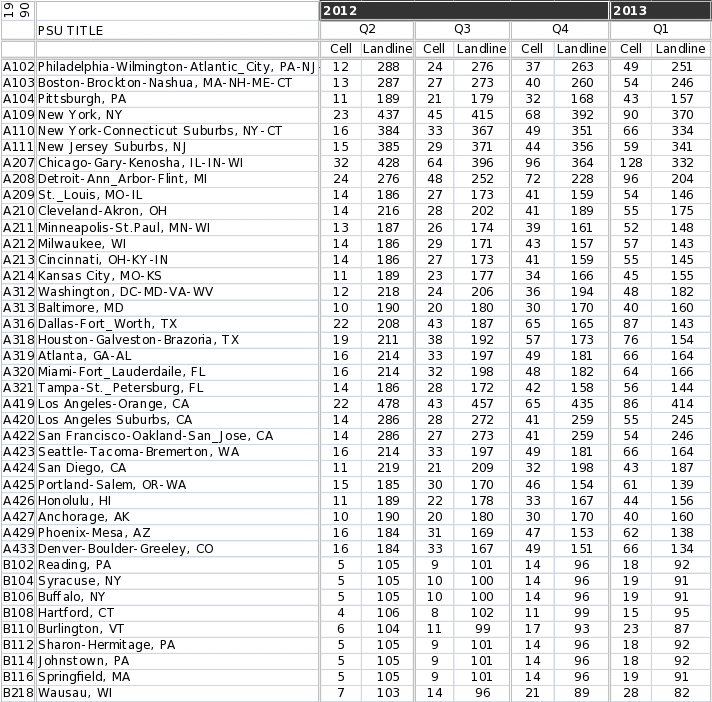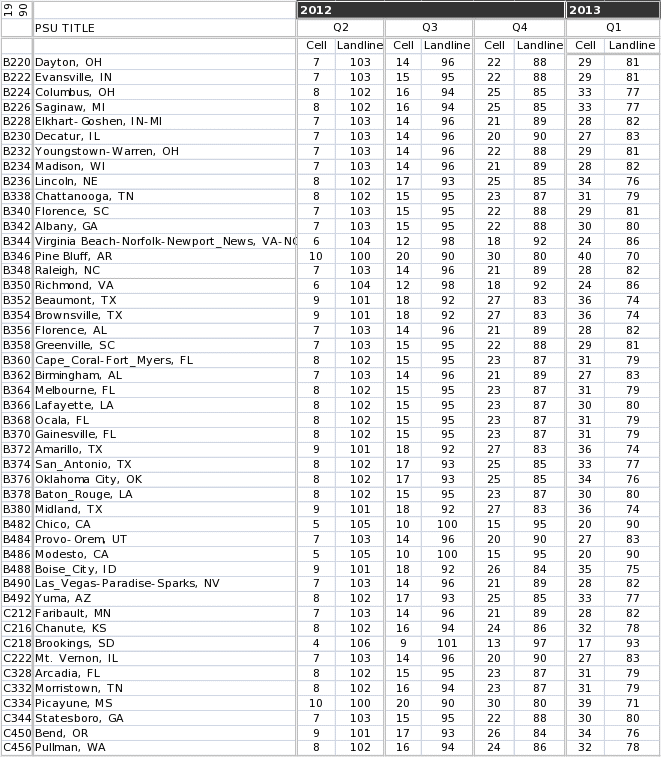Appendix B - Cell Phone Requirement
Appendix B_Cell_Production_Requirement.docx
Telephone Point of Purchase Survey
Appendix B - Cell Phone Requirement
OMB: 1220-0044
APPENDIX B Cell Production Requirement
Date: February 10, 2012
Memorandum for: Denise Pepe
Special Surveys Branch
Demographic Surveys Division
Census Bureau
memorandum from: Anya Stockburger, Section Chief
Cost Weights Section
Branch of Revision Methodology
Division of Consumer Prices and Price Indexes
memorandum thru: Rob Cage, Branch Chief
Branch of Revision Methodology
Division of Consumer Prices and Price Indexes
Subject: TPOPS Requirement for Q122—Implementation of the Cell Phone Frame in Production
I. INTRODUCTION
In Q112, Census conducted a test to determine how many calls would have to be made to obtain a target number of interviews using a frame of cell phone numbers.
This requirement will outline the changes that will need to be made to the cell phone test instrument for implementation of a cell phone frame in production for Q122.
II. GOAL/BENEFIT
The benefit of including a cell phone frame in the TPOPS is to address a potential coverage bias caused by the use of a landline-only design.
III. PARAMETER FILE CHANGES
The parameter files will not change.
IV. SAMPLING CHANGES
Marketing Systems Group will select a sample of cell phone numbers from a cell phone frame. The cell phone frame consists of 1,000-banks that have been assigned as cellular banks to a certain switch or wire center. The numbers in the banks are exclusively cell phone numbers that a cellular telephone provider owns. For example, a cellular telephone provider could own all phone numbers in the bank 123-456-7XXX. In the 1,000-banks, the set of cell phone numbers have the same first seven digits of a telephone number.
The switch or wire center is a cell phone tower and is the basic unit of geography for the cell phone frame. When a new cell phone number is activated, it is assigned a number that is associated with the nearest wire center. Using this frame, we have a higher likelihood of identifying a respondent near their residence.
Metro areas can have several wire centers surrounding it, whereas rural areas can have wire centers covering several counties. For certain PSUs that have few or no wire centers, TPOPS will expand the area to include wire centers from neighboring counties to compensate.
The landline/cell phone frame split has been established at the PSU level based on NHIS data (see Appendix I). For example, if the target number of complete and partial interviews is 200 for a PSU in the current landline sample, the targets for the cell phone frame and the landline frame will be 50 and 150, respectively.
Cell phone numbers will be gradually included in production TPOPS over four quarters. In Q122, targets for the first interviews of the cell phone frame in all PSUs will be split according to NHIS data and is specified at the PSU level (see the table at the end); In Q122, interviews two through four will be all landline phone numbers.
This process will be repeated for Q123-Q131.
The steady state will be reached in Q132.
V. INSTRUMENT CHANGES
Most of the changes to facilitate the inclusion of a cell phone frame have already been made for the Q112 test. HELLO_CELL, the question and responses referring to the age of the respondent answering on a cell phone, will remain the same as they were in the test instrument. The BLS understands this is inconsistent with the manner in which age of the respondent is treated for the landline frame. The prevalence of cell phone usage among teenagers requires the use of different screening questions.
This requirement outlines additional changes that must be made to the instrument to facilitate interviews two through four.
Change LANDCELL and ask the following question for all cases (panels one through four):
FOR RETURNING CASES:
(HELLO_RET)
This is … from the US Census Bureau. May I please speak to: fill [respondent name]?
1. This is the correct person skip to LANDCELL
2. Correct person called to the phone skip to LANDCELL
3. Person not home or available now skip to LANDCELL
4. Person unknown at this number skip to LANDCELL
5. Other outcome or problem interviewing respondent, including immediate hangup skip to PROBCALL
LANDCELL
(LANDCELL) Are you answering using a landline phone or a cell phone?
1. Landline
2. Cell phone
The following logic will also apply for replacement households.
If FRAME = 1 and LANDCELL = 1, skip to ID_SPVR
If FRAME = 1 and LANDCELL = 2, skip to CELLSAFE.
If FRAME = 1 and LANDCELL = don’t know or refuse, skip to CELLSAFE.
If FRAME = 0 and LANDCELL = 1, skip to ID_SPVR.
If FRAME = 0 and LANDCELL = 2, skip to CELLSAFE
If FRAME = 0 and LANDCELL = don’t know or refuse, skip to CELLSAFE.
(CELLSAFE) Since we have reached you on your cell phone, we want to ensure your safety. Are you currently driving?
Yes—skip to SHOW_CTRL and set a callback
No—(and HELLO_RET= 1 or 2), skip to ID_SPVR
CELLSAFE=2 (and HELLO_RET =3, skip to HELLO_RS
CELLSAFE=2 (and HELLO_RET = 4, skip to HELLO_NEW
Other outcome/problem interviewing respondent, including immediate hangup. skip to PROBCALL
Don’t know/refuse— skip to TY_CLBCK and set a callback
(ID_SPVR)
My supervisor is working with me today and may listen in to evaluate my performance.
Continue with interview skip to GEO_VER
Inconvenient time, callback needed skip to TY_NXTTM
Refused to participate skip to TY_NXTTM
Language problem OR refer to supervisor skip to TY_NXTTM
(HELLO_RS) (delete “…uses this phone,”)1
Perhaps you can help me. I’d like to speak with a member of this household who is 18 years old or older and is either related to ^fRES_NAME by blood, marriage,or other legal arrangement or who shares major living expenses with ^fRES_NAME.
Respondent is resident 18+ skip to INTRO_RS
Resident 18+ called to phone skip to INTRO_RS
Eligible person not home now or not available now skip to TY_CLBCK and set a callback
No one living in household is 18+ skip to FIND_OTH
Other outcome/problem skip to PROBCALL
Verify the state and county in which the respondent lives:
(GEO_VER)
Is your household still located in [fill from household location from last interview]?
Yes (skip to GEO_DONE)
No (skip to DFFSTATE and follow path for movers)
(DFFSTATE)
In which state do you live?
The interviewer should enter the two letter state code.
If the state is included in the CPI, the next screen (DFFCNTY) asks for the county in which the respondent lives. If the state is not included in the CPI, the case is out-of-scope, and the instrument would skip to THANKRES.
(DFFCNTY)
In which county do you live?
The interviewer will start to enter the first letters of the county, and a trigram search will pop up to list the counties in the state that begin with those letters.
If the county reported by the respondent is not included in the CPI geography, the case is a geographic screen out, is out-of-scope and would skip to THANKRES.
If the county is included in any CPI PSU, GEO_LONG will need to be adapted to use the fill from the county in which the respondent lives instead of the county for which the case was selected.
GEO_LONG:
How long have you lived in [fill: PSU name]?
The next screen after GEO_LONG will remain GEO_DONE.
CP_OLTNM
What are the names of all the places where there were expenses for [Commodity Code]?
Interviewer instructions should include the following:
If an outlet such as Groupon, or Living Social is reported, probe for the location the expense was intended for and enter it as the outlet name.
SHOPPING CENTER LIST
If the county and state changes for a respondent in interviews two through four, CP_LOCSC will be disabled. If CP_OLTYP is answered 1 Personal visit to [outlet name], the instrument will go to CP_STRT.
For returning cases, do not ask DM_LANDLINE or DM_CELL, as well as the following demographic questions: DM_LVQTR, DM_RELAT, DM_SEX, DM_MARTL, 1, DM_SPNSH, DM_RACE, DM_AGE, and DM_ELDER.
ADDRESS QUESTIONS:
Ask the address questions for cell phone cases for which an address has not been collected:
TY_R_ADDRESS1
TY_R_ADDRESS2
TY_R_CITY
TY_R_STATE
TY_R_ZIP
TY_DAYS_TIMES
TY_CMBLS
VI. WEIGHTING
The weighting specifications outlined in the August 28, 2011 “High-Level Discussion of Weighting for a Landline and Cell Phone Sample Design” will be followed for production.
POST PROCESSING
Post processing work will include populating the production datasets with the new variables and or values, calculating weights based on the new variables, and creating the output.
For households that have moved to a different CPI PSU, the variable PSU must be changed to reflect the PSU into which the household moved. For example, if a phone number is selected for B224, but the respondent that we reach has moved to A109, the PSU variable for the case should be the new PSU in all datasets: OLT, SRVC, ADR, ADR2, SPSU, SPP, and GEO.
In cases where the household had moved to a location outside of a defined PSU area (not in sample) then the variable PSU will be set to ‘0000’ and the AAPOR code set as ‘Out of sample’ (410).
The variable PSU_ORIG will be added to the GEO file to indicate the PSU for which the phone number was selected. The variable PSU_LIVE will be deleted in production and the variable PSU will be updated to reflect where the household moved to.
In all cases FAMID will not change; the first four digits will always be the PSU the household was sampled for (PSU_ORIG).
Outcome codes for military households will be correctly mapped to AAPOR code 451 (military) and FINSTAT code 06 (military) when HR_ARMFC=1.
VII. OUTPUT
The data from the cell phone frame in production shall be included with the production datasets. (No changes to the current production output.) Standard output for Don’t Know and Refused apply to all of the new variables.
GEO dataset:
PSU_ORIG—PSU for which the phone number was originally selected.
WGT dataset:
Weighting fields for output will be specified in a separate document.
VIII. TRAINING REQUIRED
Interviewers will need to be trained on the questions for the cell phone frame regarding the safety of the respondent. They will also need to be aware of the new questions associated with geography and the question flow for returning cases.
cc Stockburger, Anya (BLS)
Cage, Rob (BLS)
Hagemeier, Kirk (BLS)
SMS Oversight Group (BLS)
SMS Team (BLS)
Ash, Stephen (Census)
Pepe, Denise (Census)
Okon, Aniekan (Census)
Arthur, James (Census)
Appendix I: Target for the cell phone and landline by quarter and PSU


| File Type | application/vnd.openxmlformats-officedocument.wordprocessingml.document |
| Author | CPI User Support |
| File Modified | 0000-00-00 |
| File Created | 2021-01-28 |
© 2026 OMB.report | Privacy Policy